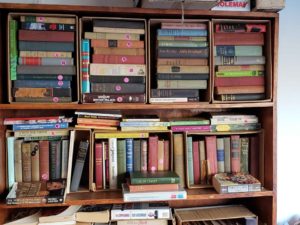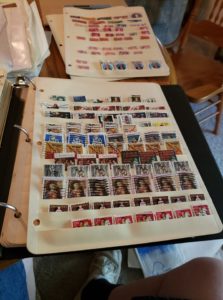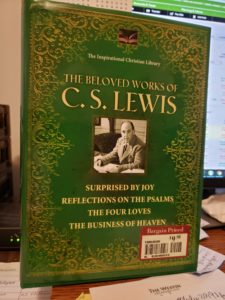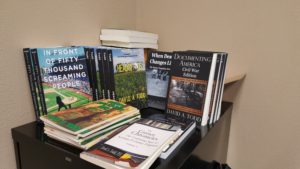
The house I grew up in had a lot of books in it. The secretary in the dining room, the bookcase with the glass doors in the hallway, and on shelves of books in the basement—some tied with twine, some in boxes, some in a row, and some under drop-cloths. I didn’t know what these books were. Once I took the drop-cloth off some and saw they were encyclopedias, published in 1900.
After Mom died and we three children grew up and moved out, Dad became an acquirer of books. He was retired by then, and he and his friend boyhood friend, Bob Tetrault, would get together once a month, have lunch, then go to flea markets. I don’t know what Bob bought (if anything), but Dad bought books. He bought paperbacks, hardbacks, on a variety of subjects. Seemingly mindless that he already had more than a thousand of Mom’s books, he bought more—and read them.
When Dad died 32 years after Mom did, and we cleaned out the house, I took the books. I sorted them into three categories: those it seemed Dad acquired, which were published mainly 1970 and later; those older than that that Mom had acquired, mainly hardbacks from the 1930s and 1940s; and then much older books, all hardbacks. These, I learned, had belonged to David Sexton, Mom’s grand-uncle, the man who took my grandmother in as a single mother and gave her a home. These are mainly from the late 1800s, though I found some that went back as early as 1829. I think my brother sold off a few older ones before I took the bulk of them away, but that’s another story.
Now we come down to 2020 and our new effort to reduce our possessions, looking toward that day sometime in the future when we’ll downsize and likely move away. As I reported in a prior post, I’m identifying things to part with and selling them on Facebook Marketplace—with some success. Dad’s tools, taking up space in boxes on shelves in the garage, are gone, at least many of them are. I still have a few. Toys that the grandchildren have outgrown are slowly going. We’ll give a number of them away to a needy family, sell others. Clothes that are surplus or that no longer fit (mostly due to weight loss) are being identified, sorted, and priced in anticipation of a yard sale a week from now. I’ve reported earlier about reduction in papers (cards, notes, letters), something that is on-going and not related to selling.
That brings us down to the books. What to do about them? Uncle Dave’s books are obviously keepers. Not many people have a set of Thomas Babbington Macaulay’s writings published in 1856, and another set from 1905. Not many have Shelley, Keats, Wordsworth, Longfellow, Tennyson, and Kipling from the 1800s. My interest in Thomas Carlyle began because of his books Uncle Dave left behind. The many books that Dad collected we can obviously get rid of. A few would be worth keeping and reading. We’ll sort through them, see what’s good, and keep them. That would be maybe 1 or 2 of 100.
The books that came from Lynda’s dad and mom are more contemporary. The subjects vary from World War 2 to Christian living. I suspect most of those will go. They are not as numerous as the books my parents had, and are not keepsakes. The books we accumulated on our own are a little tougher. If we read them they can go. If we haven’t read them, are we likely to read them? If yes, we keep; if no, out they go. I suspect this will be 50-50. That will get rid of another thousand or more.

What about Mom’s books? This is the hardest part of the decision. Over the years, at yard sales and when we briefly sold books on line from 2000-2003, I’ve sold a few of them. Now, however, I’m looking at selling maybe 700 of them if I can find buyers. At the end of that, I might find a good place to donate them, or sell them to a used book store or dealer for 25¢ on the dollar. This is hard, harder than selling Dad’s tools. Harder than selling anything I acquired over the years. Mom bought these books and, I believe, read all of them. It’s a piece of her I have clung to, hoping to read them myself and experience them as she did. Alas, if I could read two a month it would take me 42 years to go through them all. Will I live to be 110 and read these books to the exclusion of all others? Give up all my other interests just to read these books? I don’t think so.

As buyers come by and take a few of Mom’s books, I look at the half-title page, where she always signed it and put the date she bought it. I look at that and come close to crying. Another piece of Mom gone.
But what else is there to do? My children don’t want these books. My grandchildren, I’m sure, won’t want them either. As Emerson said, each generation must write their own books. Very few people in our family are still alive who knew Mom, with a few more who knew about her. Someday these will all be gone. Should I leave that task to someone who comes after me, letting them make a hard decision?
No, I’ll make that hard decision. It won’t happen in a day, but over months, perhaps years. Slowly these books will go. I’ve pulled a few out to read, and will get through them.
















